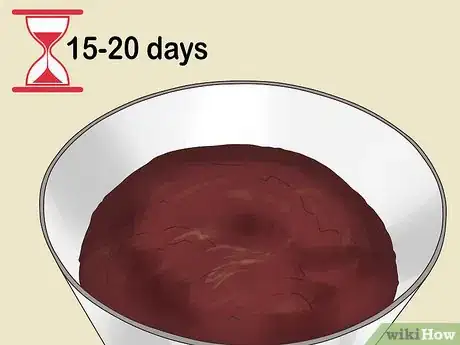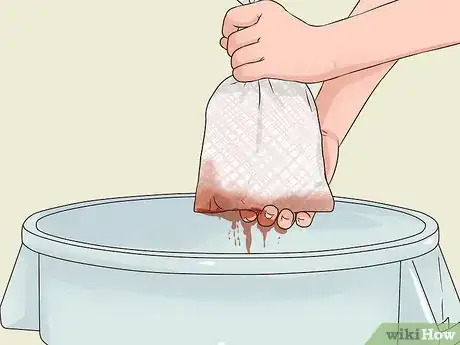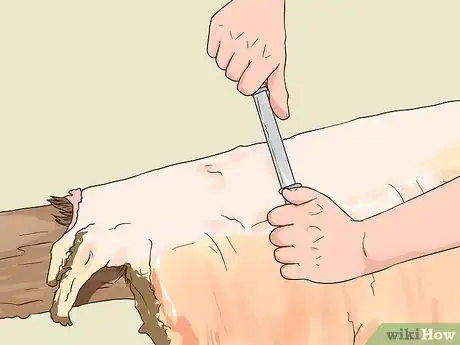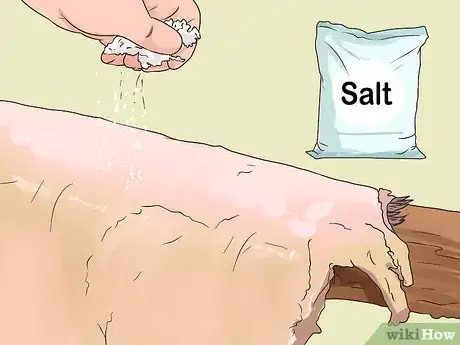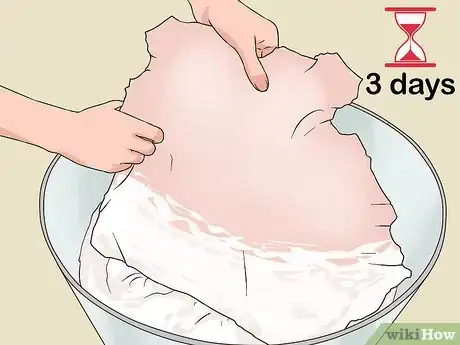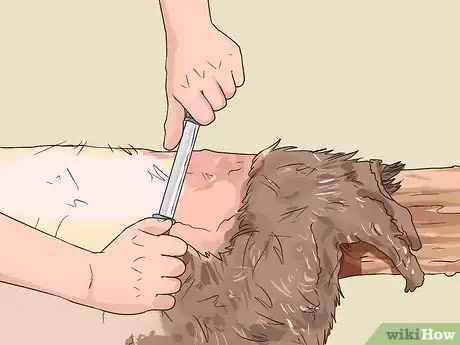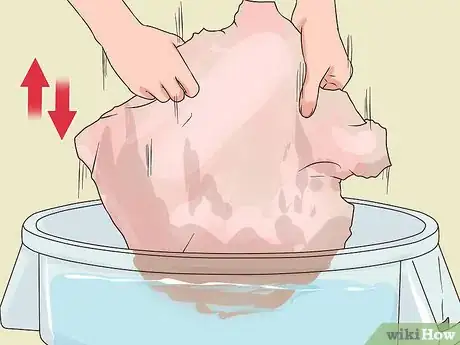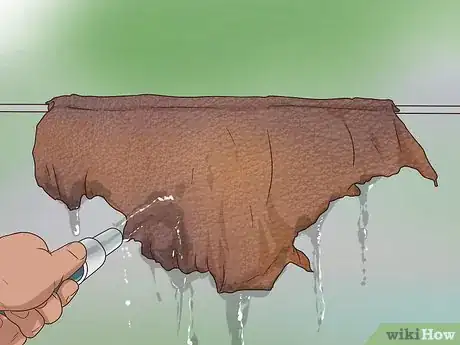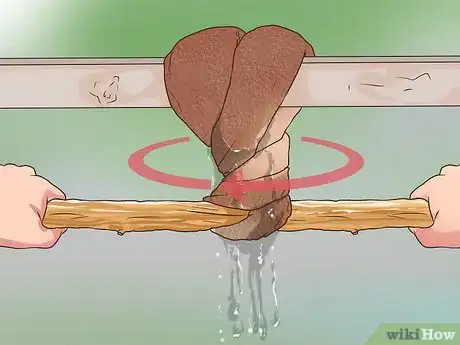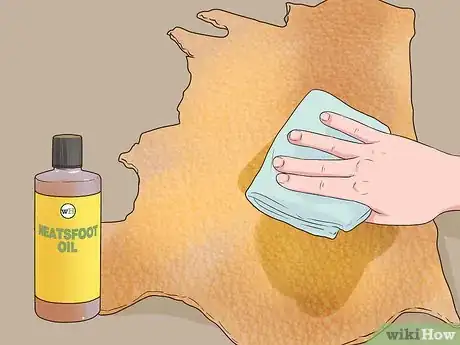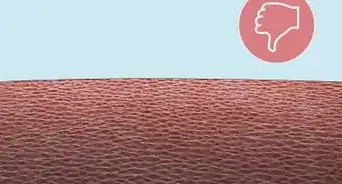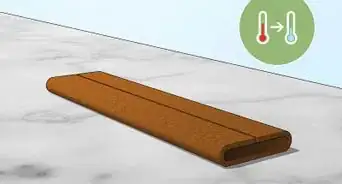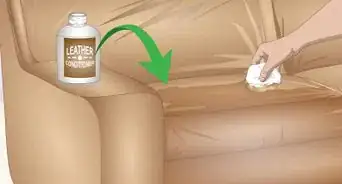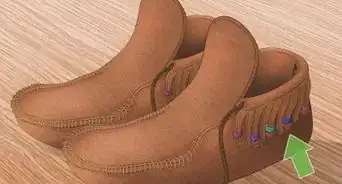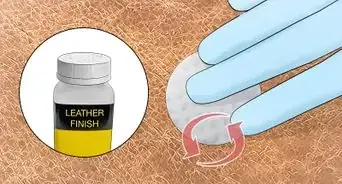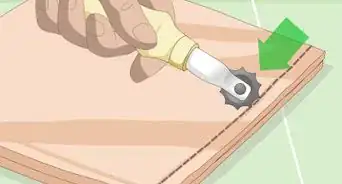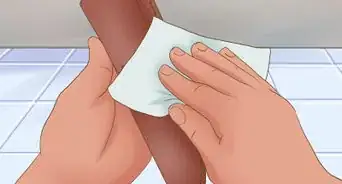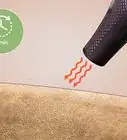This article was co-authored by wikiHow Staff. Our trained team of editors and researchers validate articles for accuracy and comprehensiveness. wikiHow's Content Management Team carefully monitors the work from our editorial staff to ensure that each article is backed by trusted research and meets our high quality standards.
There are 7 references cited in this article, which can be found at the bottom of the page.
This article has been viewed 25,938 times.
Learn more...
Bark tanning is the ancient process of creating a durable, water-repellent leather by tanning animal hide with tree bark. Bark tanning takes several months to complete but will result in a finished leather that you can use to create clothing, hinges, saddles, boots, wallets, bags, and other leather items. If you create the tree bark liquor or solution with the right ingredients, prepare the animal hide correctly, and use the right process to dye the hide, you can bark tan cattle, horse, buffalo, or pig hides.[1]
Steps
Making the Bark Solution
-
1Select and obtain tree bark. White oak gives the leather a yellowish shade while chestnut oak turns hides a dark brown. Hemlock bark will give the leather a dark reddish-brown color. Decide on what kind of finish you want for your hide and then visit a saw mill or pull off the bark from trees on your own property.[2]
- Fresh bark is the best type to use for the solution.
- You’ll need 30-40 lbs of bark for the solution.[3]
- Bark is best extracted during the spring.
-
2Grind up the bark. Use a wood shredder or chipper to grind up the bark until the bark is chipped to the size of corn kernels. You can rent a wood chipper from a hardware store if you don’t want to purchase one.[4]
- You can also manually break up the bark using a shovel, though this method will take much longer.
Advertisement -
3Pour 20 gallons (75.7 liters) of boiling water into a plastic container. Get a large plastic bin or container and pour boiling water into it. You’ll most likely have to boil the water in batches and add it in small increments.[5]
-
4Mix the bark with the water. Dump the bark chips into the plastic bin with water and use a stick to mix the solution together.
-
5Let the solution sit for 15-20 days. As the bark sits in the solution, the tannin will transfer to the water and will create a concentrated bark liquor.
-
6Drain the bark. Pour the bark through a sack and separate the bark solution from the bark chips. Take the drained solution and set it aside for later.
Preparing the Hide
-
1Scrape the flesh off the hide. Lay the hide out on a fleshing log, flesh side up. Scrape the hide with a dull knife to remove the flesh, blood, and fat from the hide. Move the dull blade over the surface of the flesh carefully, making sure not to tear or rip the hide. Continue to work over the hide in sections until it is free of traces of flesh.[6]
- Scraping the flesh is a time intensive process so work in one-hour sessions.
- If you don’t own a fleshing knife, you can use a butter knife.
-
2Sprinkle salt over the hide. Once the hide has been completely defleshed, lay the hide down on a flat surface, flesh side up. Sprinkle a handful of salt or 100% sodium chloride over the surface of the hide. This will help preserve it.[7]
- Do not sprinkle rock salt on the hide.
-
3Create a solution of hydrated lime and water. You can purchase hydrated lime at gardening stores or online. Pour 15 gallons (56.78 l) of water and 4 pounds (1.81 kg) of hydrated lime into a plastic tub. Mix the solution together thoroughly with a stick.[8]
- Wear rubber gloves when working with hydrated lime.
-
4Soak the hide in the hydrated lime solution for three days. The hydrated lime and water solution will help soften the leather and loosen up the hair on the hide so that you can remove it easily. Submerge the hide into the lime solution and let it sit for three days, stirring the solution three to four times a day.[9]
-
5Scrape the hair off of the hide. Place the hide on the fleshing log again and use a dull blade to scrape the hair off of the surface of the hide. Press the edge of dull blade against the hair-covered side of the hide and pull it down until the hair comes off. Continue to scrape the hair until you remove the top layer of dark skin or epidermis.[10]
- The hydrated lime solution should make it easier to remove the hair.
-
6Rinse the lime off the hide. Soak the hide in a bin filled with water and agitate the hide so that you remove any traces of the lime solution. Replace the water 5-6 times over a 12 hour period and continue to agitate the hide to thoroughly remove all of the lime.
Dyeing the Leather
-
1Dilute the first bark bath. To dilute the bark bath, pour 5 gallons (18.92 l) of the undiluted bark solution into a container and then add 15 gallons (56.78 l) of water to the container. Use a stick to mix the solution together. Set the undiluted solution aside to use later.[11]
- Using a concentrated bark solution for the initial tanning will inhibit the bark solution from penetrating into the center of the hide and will make the hide stiff and useless for many leather applications.
-
2Submerge the hide into the solution and stir it. Submerge the hide in the solution and mix it for 10 minutes. Let the leather sit in the solution for another 10 minutes, then mix it again. Continue mixing the leather in 10-minute intervals for the first hour.[12]
-
3Let the hide sit for one week. After the first hour, move the bin somewhere where it won’t be disrupted. Let the leather sit in the solution and it will start absorbing the dye in the bark solution.
-
4Add more of the undiluted bark solution to the container. After a week passes, drain 5 gallons (18.92 l) of solution from the bin, then add another 5 gallons (18.92 l) of the undiluted bark solution to the water. Adding more undiluted bark solution will help darken it.[13]
-
5Let the hide soak until it’s as dark as you want it. Let the hide soak for another week, then remove five more gallons (18.92 l) of the solution and add 5 gallons (18.92 l) of undiluted bark solution to the container. Continue to do this for two more weeks, or until you run out of undiluted bark liquor.
-
6Rinse the dyed leather. Rinse the leather for two hours with cold running water. Some of the bark liquor should rinse from the hide.
-
7Wring the moisture out of the hide. Wrap a clean rag around a wooden beam. This will act as a squeegee. Put the beam wrapped in the rag on top of the leather and press and slide it across the surface. This should squeeze out the water from the leather. Turn the leather over and squeeze the water out of the other side.[14]
-
8Oil the leather. Purchase neatsfoot oil, olive oil, tallow, bear fat, or fish oil and apply it over the surface of the leather. Apply the oil to a cloth, then rub the cloth onto the surface of the hide. Oiling the leather will prevent cracking. Rub a thick coat of oil onto the surface until the leather looks somewhat shiny.[15]
-
9Hang the leather to dry. Hang the leather up to dry with clothespins for a 24 hour period. Once the leather is dried, you can remove any excess oil with a clean cloth.[16]
Things You’ll Need
- Tree bark
- Water
- Wood chipper/shredder
- Plastic container
- Dull knife
- Salt
- Hydrated lime
References
- ↑ http://www.braintan.com/barktan/1basics.htm
- ↑ http://northernwoodlands.org/articles/article/hemlock-and-hide-the-tanbark-industry-in-old-new-york
- ↑ http://www.offthegridnews.com/how-to-2/how-to-tan-leather-just-like-your-great-grandfather/
- ↑ http://www.offthegridnews.com/how-to-2/how-to-tan-leather-just-like-your-great-grandfather/
- ↑ https://braintan.com/barktan/1basics.htm
- ↑ http://www.liv18thc.com/barktan.html
- ↑ http://www.texasmonthly.com/the-culture/how-to-tan-a-deer-hide/
- ↑ http://www.liv18thc.com/barktan.html
- ↑ http://www.liv18thc.com/barktan.html
- ↑ http://www.liv18thc.com/barktan.html
- ↑ https://braintan.com/barktan/1basics.htm
- ↑ https://braintan.com/barktan/1basics.htm
- ↑ https://braintan.com/barktan/1basics.htm
- ↑ https://braintan.com/barktan/1basics.htm
- ↑ https://paleotechnics.wordpress.com/2013/04/14/the-most-common-bark-tanning-mistakes-pitfalls-to-avoid-on-your-way-to-beautiful-leather/
- ↑ https://braintan.com/barktan/1basics.htm




